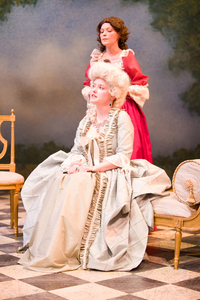Performance Network presents a beautiful, if somewhat cool, look at 'Marie Antoinette'

Jill Dion, top, and Chelsea Sadler in "Marie Antoinette: The Color of Flesh"
photo by Sean Carter | courtesy of Performance Network
Twenty years of French history, from 1774-1793, form the backdrop for “Marie Antoinette: The Color of Flesh.” But Gross paints the grand sweep of “liberte, egalite, fraternite” on an intimate canvas in this three-character drama, with France’s most famous queen at its center and a love triangle as its heart.
The Performance Network production, directed by Shannon Ferrante, is beautifully conceived to showcase the passions (romantic and otherwise) that motivate its characters: the Queen herself; Count Alexis (based loosely on the real-life Swedish count Axel Ferson); and the queen’s portraitist and confidante Elisa (based on royal painter Elisabeth Vigee Le Brun). And yet, despite all the wooing and the profligate professions and protestations of love and friendship, the play’s temperature sometimes falls to tepid as Alexis (Drew Parker) beds both queen (Chelsea Sadler) and painter (Jill Dion).
To play out their alliances and allegiances, set and costume designer Monika Essen has given the actors an evocative boudoir-cum-studio set that makes for easy transition between scenes and locales. We are inside—a match for the characters’ focus. But these free-flowing rooms, framed with giant, gilded Rococo curlicues that suggest Versailles, overlook a garden of cool blues and greens that turns from haven to flame-skied hell as the People have their say about the monarchy. At the end, Daniel C. Walker’s lighting tenderly suggests the prison bars that hold Marie Antoinette captive before she goes to her death. Philip Powers’ sound score likewise suggests the era.
Director Ferrante uses the set cleverly and creatively. Alexis, just back from fighting in the American Revolution, returns to his lover Elisa; he professes his great love, but Ferrante tells the tale of his fickleness in a flash—she caps the reunion with Alexis entering Elisa’s bed from the left and, love-making over, tumbling out on the other side to arrive on bended knee to kiss the queen’s hand. You know what the next stop will be.
Just as acutely, the actors tell much with small gestures—Dion’s coquettish, outspoken Elisa thrusts her chin forward defiantly; Sadler’s Marie Antoinette is hilariously all elbows as she depicts her frustration with her royal husband’s amatory ineptitudes. As Alexis, Parker is perhaps least successful in vivifying his character, an aristocrat who would be a populist (but has never met a peasant, as Elisa so bluntly puts it). But then, playwright Gross has given him the speechiest, preachiest lines (and he has not one, but two bad wigs to contend with). He’s supposed to come across as naïve, if lofty in his ideals, but Elisa’s reproach that he sounds as if he’s memorized a tract when he starts in on his politics doesn’t quite excuse the woodenness to which his delivery is prone.
Like Alexis, the Marie Antoinette Gross gives us is also a naïf. Elisa is more savvy, but perhaps no more self-aware than the queen and count whom she loves. All three mature—as they should over the play’s purported 19-year time span. But Gross’s other themes, of beauty as surface and beauty as inner light, and of their realization in life and art, lend the play a certain coolness that the actors did not quite transcend on opening night. Elisa talks of painting the color of flesh, and of how, when the queen is roiled, her reddened complexion is beautiful to her as a visible mark of emotion. A little more red—and less blue for gray times, as Alexis puts it when looking at a portrait Elisa has painted—would benefit the show.
"Marie Antoinette: The Color of Flesh" continues through Aug. 28. For tickets or information, see the Performance Network website.

